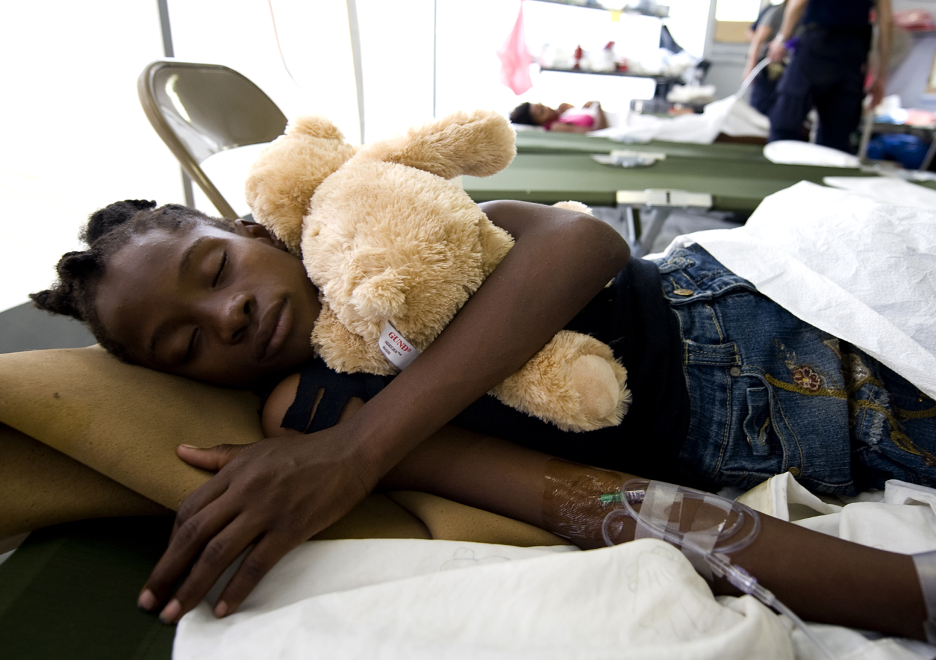
Figure: A young girl sleeps with a teddy bear in her arms after receiving medical treatment at Gheskio Field Hospital (Joshua Lee Kelsey, Wikimedia Commons).
For many children, stuffed animals are loyal and comforting companions. A fluffy friend can make a trip to the doctor or sleeping in the dark seem a little less daunting. For these children, stuffed animals serve as transitional objects – inanimate objects that provide comfort, particularly in unfamiliar or distressing situations (Winnicott, 1953). Although stuffed animals are seen as children’s toys, they can also serve as transitional objects for adults. Along with being a source of comfort, stuffed animals can also provide other mental and physical benefits for the children and adults who own them.
For children, stuffed animals can aid in developing and maintaining sleep habits. For instance, in a study of school-age children and parents of school-age children, Golem et al. (2019) used questionnaires and discussion groups to ascertain the beliefs and attitudes that the participants had towards sleep. Among the topics discussed, they found that stuffed animals were an important point of discussion among child participants. Specifically, the children described the physical and emotional comfort and support that their stuffed animals provide for them at bedtime (Golem et al., 2019).
Additionally, stuffed animals can help encourage children to read. In another study of preschool children, Okazaki et al. (2017) investigated the use of a stuffed animal sleepover program to encourage children to read. To do this, they first gave children stuffed animals that were left in a library overnight. The stuffed animals were photographed performing different activities to convince the children that they were magical and sentient. The children were then left a note from the stuffed animals, which requested the children to read to them. Throughout the intervention, Okazaki et al. (2017) also observed the children and recorded the number of children who read picture books to the stuffed animals during free playtime before and after the program. They found that there was an increase in the number of children who read to stuffed animals after the stuffed animal sleepover program, compared to before the program. While the effects of the program disappeared after three days, Okazaki et al. (2017) found that reminding children of the program one month out by asking them to describe what the stuffed animals did during the sleepover helped boost their tendency to read.
Finally, stuffed animals may help prevent pain for children following surgery. In a study of pediatric patients between the ages of 1 and 7 who had undergone surgery, Ullán et al. (2014) provided the children with a rabbit stuffed animal dressed up as a doctor, along with instructions for parents to use the stuffed animal to play with their child after surgery. They also took measures of the children’s pain based on their behaviors post-surgery, such as facial expressions or crying. Overall, Ullán et al. (2014) found that the children who received the stuffed animal and instructions to play scored lower on the pain measurements (meaning that they exhibited less pain), compared to children who did not. The researchers proposed two explanations for the findings: playing with the stuffed animals could have distracted the children from pain, or playing with the stuffed animals could have improved the children’s mood, which in turn could influence their experience of pain.
Meanwhile, for older adults, stuffed animals have been used in therapeutic activities too. In a pilot study involving two nursing homes, Trzinski and Higgins (2001) developed exercises and activities designed to increase cohesion and socialization among residents. These activities included physical exercises, games, and having stuffed animals as “group buddies” that accompany residents to group sessions (Trzinski & Higgins, 2001). They found, based on a follow-up with residents one year after introducing the activities, that residents still socialized with their group members and took part in the activities, including using the stuffed animals, even after the groups were dismissed. Although future research is needed to understand the effectiveness of the program and which activities were effective in increasing cohesion and socialization of the nursing home residents, the results from this study serve as an example of how stuffed animals might have therapeutic benefits when used in tandem with other treatments and methods.
Stuffed animals have also been studied in the context of young adult social behavior. In a series of studies of undergraduate students, Tai et al. (2011) had participants read statements that induced feelings of being socially excluded, touch a teddy bear, and then take part in an activity where they were tasked with allocating money to others. Control participants performed the same activities but did not touch a teddy bear. Across these studies, they found that participants who had experienced both social exclusion and touched a teddy bear acted more pro-socially by agreeing to volunteer for more experiments and by offering more money than participants who had been socially excluded but did not touch the teddy bear. This pattern of findings demonstrates that touching a stuffed animal might alleviate the negative impacts of being socially excluded while also increasing prosocial behavior.
Lastly, stuffed animals can help inform research that benefits adults with borderline personality disorder (BPD). Specifically, stuffed animals may serve as an indicator of BPD in adults, in conjunction with other signs and symptoms. For instance, in a study of a nonclinical sample of 80 adults, Hooley and Wilson-Murphy (2012) interviewed participants and also used a series of questionnaires to investigate the relationship between BPD (as well as related pathologies and issues) and transitional objects, which included stuffed animals among other objects. Overall, they found that participants who had more intense attachments to transitional objects also had higher scores on measures of borderline pathology, compared to participants who had less or no attachments to transitional objects. Furthermore, 78% of the participants who reported intense attachments to transitional objects reported attachments to stuffed animals (Hooley & Wilson-Murphy, 2012). These findings are supported by another study of adult female psychiatric inpatients, where Labbate and Benedek (1996) found that diagnoses of BPD were common among women who had stuffed animals in their living spaces. Although having a stuffed animal does not necessarily mean that an adult has BPD, stuffed animals can help researchers better understand factors that contribute to the development of BPD and develop effective treatments for the condition.
Although the body of research on stuffed animals is only beginning to grow, stuffed animals are more than just toys. They have a host of potential benefits for both children and adults. For children, stuffed animals can provide comfort and security at bedtime, opportunities to develop and practice reading skills, and relief from pain in post-surgical settings. Meanwhile, for adults, they can be used to help researchers study and understand BPD, develop and augment therapeutic programs for nursing home residents, and increase prosocial behavior. Future research will be necessary to validate and refine these studies and to expand on their findings and limitations. However, from the published research, we know that our cuddly companions won’t be leaving us anytime soon.
References
- Golem, D., Eck, K. M., Delaney, C. L., Clark, R. L., Shelnutt, K. P., Olfert, M. D., & Byrd-Bredbenner, C. (2019). “My stuffed animals help me”: The importance, barriers, and strategies for adequate sleep behaviors of school-age children and parents. Sleep Health, 5(2), 152–160. https://doi.org/10.1016/j.sleh.2018.11.003
- Hooley, J. M., & Wilson-Murphy, M. (2012). Adult Attachment to Transitional Objects and Borderline Personality Disorder. Journal of Personality Disorders, 26(2), 179–191. https://doi.org/10.1521/pedi.2012.26.2.179
- Labbate, L. A., & Benedek, D. M. (1996). Bedside Stuffed Animals and Borderline Personality. Psychological Reports, 79(2), 624–626. https://doi.org/10.2466/pr0.1996.79.2.624
- Okazaki, Y. S., Asakawa, A., Ishii, K., & Yamada, Y. (2017). The stuffed animal sleepover: Enhancement of reading and the duration of the effect. Heliyon, 3(2). https://doi.org/10.1016/j.heliyon.2017.e00252
- Tai, K., Zheng, X., & Narayanan, J. (2011). Touching a Teddy Bear Mitigates Negative Effects of Social Exclusion to Increase Prosocial Behavior. Social Psychological and Personality Science, 2(6), 618–626. https://doi.org/10.1177/1948550611404707
- Trzinski, A., & Higgins, J. (2001). Therapeutic Play Activities. Activities, Adaptation & Aging, 25(3–4), 121–135. https://doi.org/10.1300/J016v25n03_09
- Ullán, A. M., Belver, M. H., Fernández, E., Lorente, F., Badía, M., & Fernández, B. (2014). The Effect of a Program to Promote Play to Reduce Children’s Post-Surgical Pain: With Plush Toys, It Hurts Less. Pain Management Nursing, 15(1), 273–282. https://doi.org/10.1016/j.pmn.2012.10.004
- Winnicott, D. W. (1953). Transitional objects and transitional phenomena; a study of the first not-me possession. The International Journal of Psycho-Analysis, 34(2), 89–97.
Related Posts
When the Brain Loses a Sense, How Does it Compensate?
Source: Wendel Moretti The brain plays a crucial role in...
Read MoreThe Gut May Be The Door to Effective Depression Treatment
First Author: Jillian Troth1 Co-Authors [Alphabetical Order]: Roxanna Attar2, Caroline...
Read MoreThe Critical Role of Sleep in Determining Reaction to Daily Life
Source: Pixabay Sleep plays an extremely important role in physical...
Read MoreThe Positives of Plushies: Stuffed Animals Have Benefits for Children and Adults
Figure: A young girl sleeps with a teddy bear in...
Read MoreCOVID-19 May Inflict Lasting Damage on the Central Nervous System
Figure 1: Transmission electron microscope image of the SARS-CoV-2 virus....
Read MoreHuman Endogenous Retroviruses Might Unlock a New Field of Neurodegenerative Disease Research
Figure 1: Researchers have found viral genetic materials within the...
Read MoreVincent Lai






